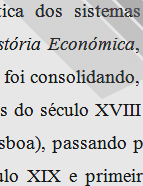

................................
In his mature phase (mid-1880s to 1908), Sampaio focused intensely on building his historiographical oeuvre, with key titles including A propriedade e a cultura do Minho [Property and culture in Minho](1885), O Norte Marítimo [The Maritime North] (1889), As Vilas do Norte de Portugal [The Towns of Northern Portugal] (1895), and As Póvoas Marítimas [Maritime Villages] (1905-1908). As highlighted by José Amado Mendes ("Introdução" to Obras, 2008, pp. 9-27 and Idem, "Alberto Sampaio…", in press), Sampaio's work contained several innovative features. In the wake of Oliveira Marques, Sampaio has been regarded as the "father" or "true creator" of economic history in Portugal (Oliveira Marques, Antologia, vol. 2, 1975, p. 54). As has been seen, Borges de Macedo similarly claimed such a status for Rebelo da Silva who also pioneered and deepened the understanding of the origins of Portuguese nationality, having "added" thirteen centuries to Herculano's History. He paid special attention to aspects of economic history: daily life, agricultural technology, food, and clothing. Henrique da Gama Barros (1833-1925), a graduate of the Faculty of Law of the University of Coimbra, held various positions in public administration (Armando L. Carvalho Homem, "Gama Barros e a historiografia..." [Gama Barros and historiography] 2016, p. 477). However, it was as a historian that he stood out the most, with his monumental work História da Administração Pública em Portugal [History of Public Administration in Portugal] (4 volumes, 1885-1922, leaving the manuscript for a 5th volume ready at the time of his death; in the re-edition of 1945-1954, under Torquato de Sousa Soares). Although the central theme of this work is public administration, economic matters also receive his attention. Indeed, he dedicated an extensive section—Book III—under the title "Situação económica do país" ["Economic situation of the country"] which, originally intended as an introductory chapter, extended across volumes IV to X of the 2nd edition (1945-1954). In addition to his contribution to the study of public administration, economy, and society, the author "emerges [...] as a bridge between the eighteenth-century academic and the university scholar, who would come to dominate historiography from the second quarter of this century [20th century]" (Armando L. Carvalho Homem, "Gama Barros, Historiador..." ["Gama Barros. Historian"], 1985, p. 246).
